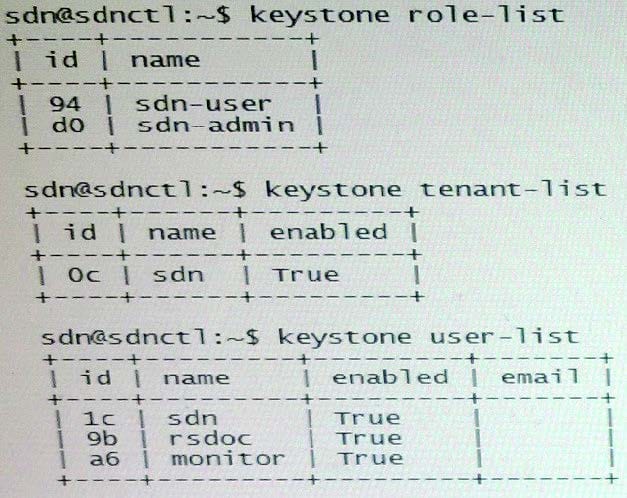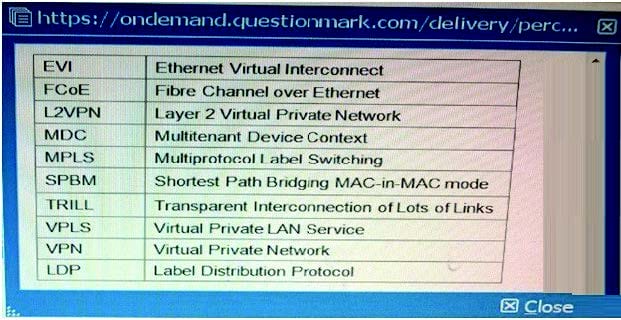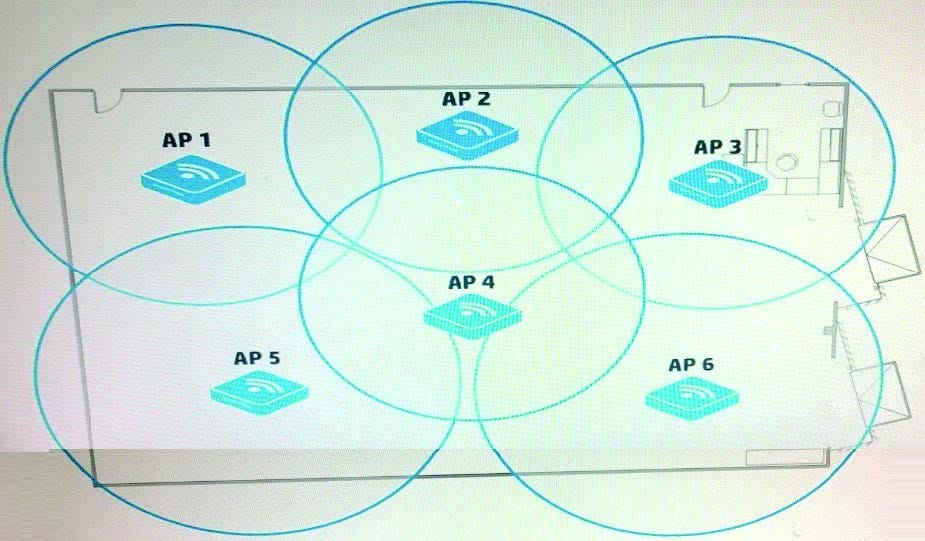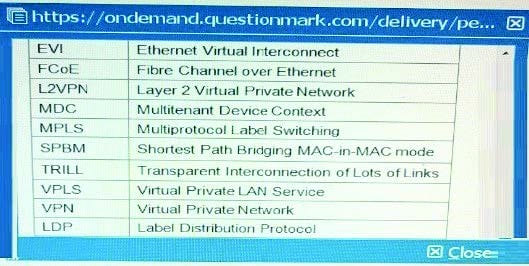HP0-Y51 Online Practice Questions and Answers
Questions 4
An administrator plans to deploy a wireless network, which might need to support a mix of 802.11g and 802.11n clients in the 2.4 GHz frequency. The administrator wants to prioritize transmissions for 802.11 n clients. Which 2.4 GHz radio setting helps to prevent slow clients from taking more than their share of transmission time?
A. Set up the channel reuse option.
B. Set up the fair scheduling option.
C. Set the mandatory data rate for 802.11g as low as possible.
D. Set the multicast data rate for 802.11n as low as possible.
Questions 5
Refer to the exhibit. (Note: the IDs in the exhibit have been truncated to simplify references to them)

An administrator creates user "monitor", who should have read only access to the HP VLAN SDN Controller. The administrator needs to enter this command to
finish up the user account.
keystone user-add-role - -user-ID ID1 - - tenant-id ID2 - -role-ID ID3
What are the correct values for ID1, ID2, and ID3?
A. ID1 = 94; ID2 = a6; ID3=0c
B. ID1 = a6; ID2 = 0c; ID3=94
C. ID1 = 9b; ID2 = a6; ID3=d0
D. ID1 = a6; ID2 = 0c; ID3=d0
Questions 6
Table of Acronyms

Refer to the exhibit.

An administrator is configuring an MPLS and VPLS Martini to connect customer Sites 1, 2, and
3. The administrator has created Virtual Switch Instance (VSI) "CustomerA" for this purpose. How should the administrator connect customer Site 1 to the VPLS solution?
A. Create a service instance on the VLAN assigned to g1/0/1. Also create a global cross-connect group, and bind the CustomerA VSI and the service instance in that group.
B. Create a service instance on g1/0/1. Also create a global cross-connect group, and bind the CustomerA VSI and the service instance in that group.
C. Create a service instance on the VLAN assigned to g1/0/1. Bind (cross-connect) that instance to the CustomerA VSI.
D. Create a service instance on g1/0/1. Bind (cross-connect) that instance to the CustomerA VSI.
Questions 7
A company has an HP BYOD solution to let guests connect to a Guest SSID and log in through a registration page. The company needs an Employee SSID which enforces Wi-Fi Protected Access 2 (WPA2) with 802.1X. Employees must authenticate with certificates. Before authenticating with a device for the first time, the employees should be able to connect to the Guest SSID, access the guest registration page, and download valid certificates.
How does the administrator configure User Access Manager (UAM) to allow employees to download certificates from the registration page?
A. The User Endpoint Settings, create an Endpoint Configuration Distribution Policy that permits the employee groups.
B. In the Guest Manager settings for the employee manager, enable auto-registration in certificate mode.
C. In the Guest access policy, make sure that a policy binds the Employee SSID to an access rule with the onboarding VLAN ID.
D. In the Employee access service, make sure that a policy binds the Employee SSID to an access rule with the onboarding VLAN ID.
Questions 8
A company has three HP VAN SDN Controllers, which will be deployed in a team. The administrator is deciding whether to create one region or three regions. What is a benefit of creating three regions rather than one region?
A. The team can load balance the team leader role, increasing the total number of RESTful API and Java API calls that the solution can handle.
B. The team can provide high availability for SDN application functions rather than only for the OpenFlow controller functions rather than only for the OpenFlow controller functions.
C. The team can load balance the Master OpenFlow controller role, increasing the total number of packetin messages per second that the solution can handle.
D. The team can provide high availability for all the OpenFlow controller functions rather than only for the SDN application functions.
Questions 9
Refer to the exhibit.

A company has many dual-radio APs that are deployed relatively closely together. They are controlled by an HP Unified Wired-Wireless controller. The administrator wants to implement load balancing among the radios on different APs.
How should the administrator implement load balancing?
A. Implement group-based load balancing by adding radios on different APs to the group.
B. Implement radio-based load balancing by adding APs to the radio templates.
C. Implement AP-based load balancing on the individual APs.
D. Implement AP-based load balancing on the radios of the individual APs.
Questions 10
An administrator has set up an HP BYOD solution for an HP MSM760 controller and its APs.
These are the specifications:
Guests should only have to register and log in once After that, the guest device should be automatically logged in.
User Access Manager (UAM) provides the portal in which guests register their own accounts.
The MSM760 is connected to a Comware switch, which redirects unregistered guests to the UAM portal.
Currently guests can reach the portal, register for their accounts, and log in. However, guests report that they cannot reach the Internet after they log in. When the administrator asks the guests to disconnect from the wireless network and then connect again, they succeed in reaching the Internet.
What could fix this problem?
A. In the Comware switch settings, add the guest router to the free rule list
B. In the DHCP scope for the onboardmg VLAN, lower the lease time to about 10 seconds.
C. Configure SOAP settings for the MSM controller on UAM.
D. Configure the Comware switch to accept dynamic authorization updates from UAM.
Questions 11
A Company has APs that are deployed relatively close together. These APs are controlled by an HP Unified Wired-Wireless controller. Which setting helps to prevent the APs from interfering with each other while also letting the APs extend their coverage area if one of the AP fails?
A. Channel reuse
B. Dynamic frequency selection (DFS)
C. Transmit power control (TPC)
D. Fair scheduling
Questions 12
Table of acronyms

Refer to the exhibit.

An administrator is setting up an MPLS and L2VPN virtual circuit (VC) between customer Site 1 and Site 2. The administrator is creating a global cross-connect group, which uses LDP signaling, on PE-1. Which two elements are required to do this?
A. An AC connection (specifies a service instance on g1/0/1) and a peer (PE-2)
B. A peer (PE-2) and a VPN instance (associated with g1/0/1)
C. A peer (PE-2) and a VLAN ID (access VLAN or. g1/0/1)
D. An AC connection (specifies a service instance on g1/0/1) and a VPN instance (associated with g1/0/1)
Questions 13
Table of Acronyms

Refer to the exhibit.

An administrator is setting up MPLS Layer 2 VPN connections between several customer sites:
Connection 1 = Customer site 1 to customer site 2
Connection 2 = Customer site 1 to customer site 3
On PE-1, interface GigabitEthernet1/0/1 connects to CE-1 at site 1. Which setup establishes the desired connections?
A. CE-1 connects to CE-2 in one VLAN, which it assigns to VPN instance 1. It connects to CE-3 in a different VLAN, which it assigns to VPN instance 2. PE-1 instant places G1/0/1 in both VPN instances 1 and 2 and associates each VPN instance with a PW for one of the connections.
B. CE-1 connects to CE-2 in one VLAN and to CE-3 in a different VLAN. PE-1 has two services instances on G1/D/1. One instance encapsulates one VLAN ID and has PW to PE-2, and the other instance encapsulates the other VLAN and has a PW to PE-3
C. PE-1 has two policy-based routing (PBR) policies, each of which selects traffic destined to Site 2 or Site 3. The appropriate policy is applied to the PW for each connection
D. CE-1 implements MPLS. It establishes two PWs with PE-1, one for its connection to CE-2 and one for its connection to CE-3. PE-1 maps the out label for the first PW to the in label for a PW to PE-2. It maps the labels similarly for a PW to PE-3.
